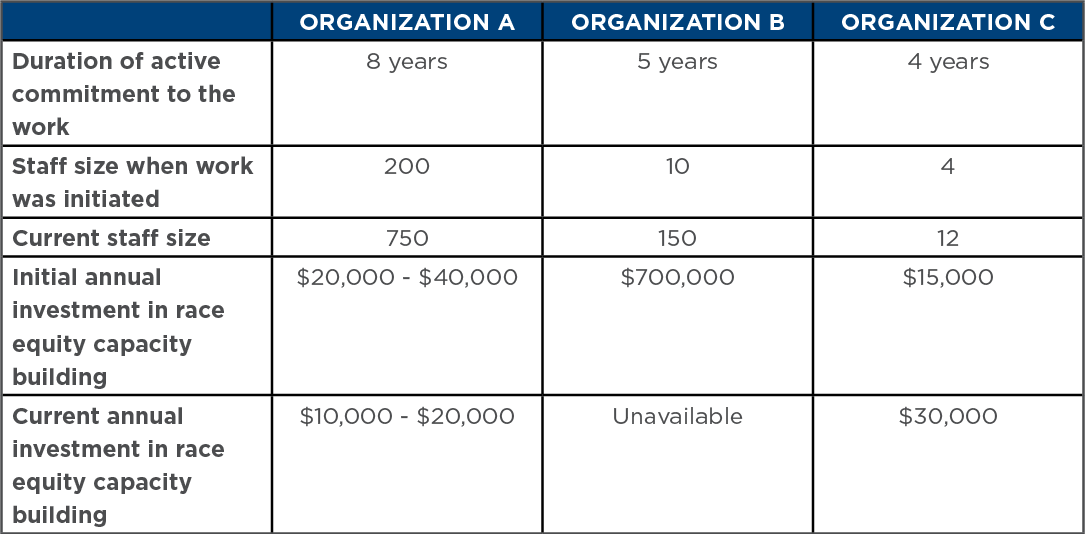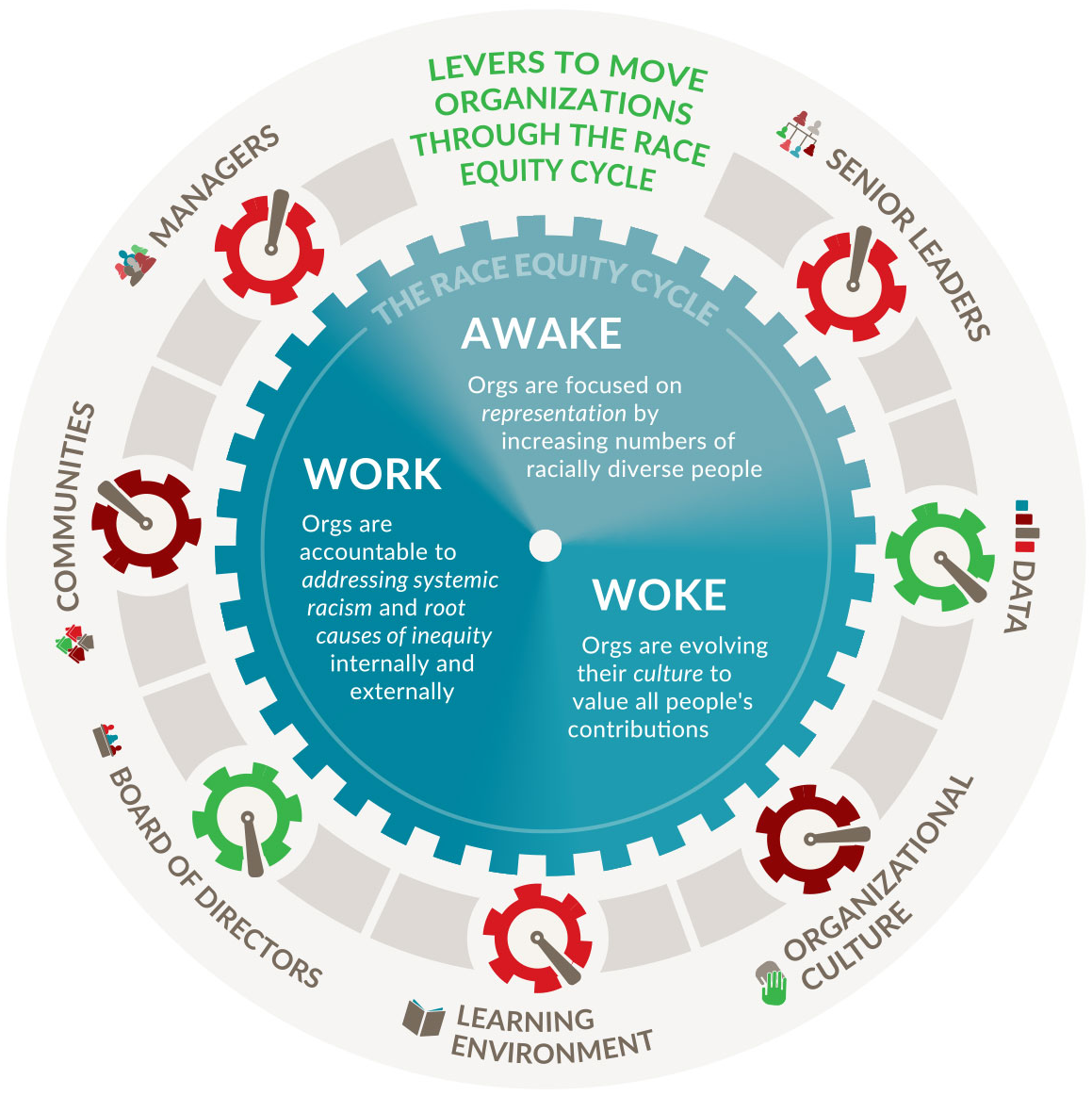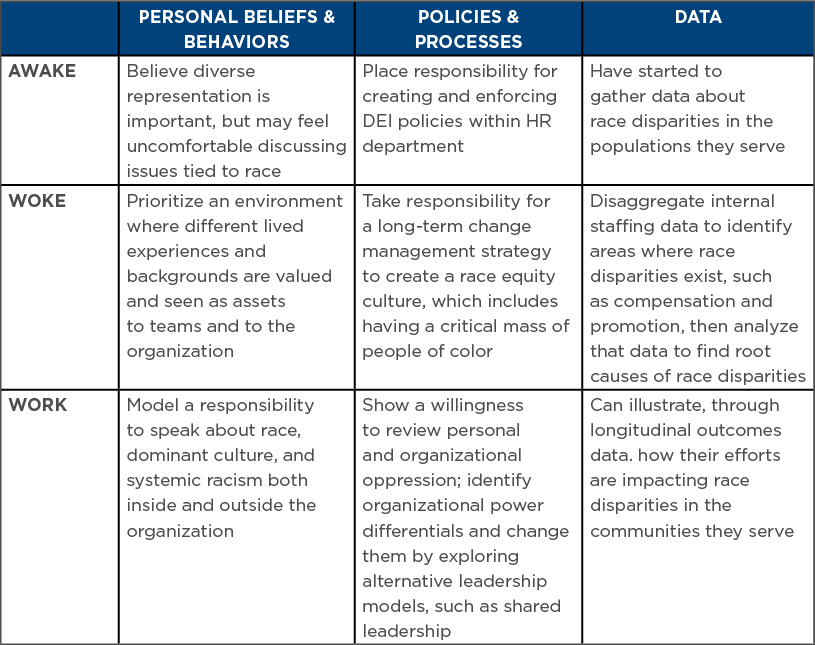The Role of Senior Leaders in Building a Race Equity Culture
By Kerrien Suarez
July 23, 2018
This piece was originally published by the Bridgespan Group.
To build an organizational culture that embraces racial equity, senior leaders need to set the tone and drive progress of the work.
Across the social sector, a fundamental element of social impact remains missing: race equity. Race equity, the condition where one's racial identity has no influence on how one fares in society,1 is essential to social change. However, it is impossible until we address the structural racism that is entrenched, not only in our nation's history and culture, but in the mindsets, policies, and practices of nonprofit and philanthropic management. This requires transformative change to these organizations, and to the sector overall.
As noted in Building Movement Project's (BMP) report Race to Lead, only 20 percent of CEO/executive directors of social service organizations and the foundations that support them are people of color. Furthermore, the common belief that bringing more people of color into the sector inevitably means that they'll rise to the leadership level is a myth. BMP's research confirmed that the talent pipeline is healthy, and that the desire for advancement among people of color is strong.
As outlined in our publication Awake to Woke to Work: Building a Race Equity Culture, I and my colleagues at Equity in the Center believe that this change, and the social impact it can drive, are possible within the context of a Race Equity Culture; that is, an organizational culture focused on the counteraction of race inequities, both internally and externally.
Our research found that senior leaders play a critical role in building a Race Equity Culture. First, they support managers and teams in examining all four levels on which racism operates in society—personal, interpersonal, institutional, and structural. Second, they foster the conditions that shift mindsets, policies, and practices toward race equity.
Four Levels of Racism
Personal: Private beliefs, prejudices, and ideas that individuals have about the superiority of whites and the inferiority of people of color. Among people of color, it manifests as internalized oppression. Among whites, it manifests as internalized racial superiority.
Interpersonal: The expression of racism between individuals. It occurs when individuals interact and their private beliefs affect their interactions.
Institutional: Discriminatory treatment, unfair policies and practices, inequitable opportunities and impacts within organizations and institutions, based on race, that routinely produce racially inequitable outcomes for people of color and advantages for white people. Individuals within institutions take on the power of the institution when they reinforce racial inequities.
Structural: A system in which public policies, institutional practices, cultural representations, and other norms work in various, often reinforcing ways to perpetuate racial group inequality. It is racial bias among institutions and across society. It involves the cumulative and compounding effects of an array of societal factors including the history, culture, ideology, and interactions of institutions and policies that systematically privilege white people and disadvantage people of color.
Source: Adapted from Interaction Institute for Social Change.
Overcoming the Challenges to Building a Race Equity Culture
While senior leaders across the sector increasingly express a desire to build a Race Equity Culture within their organizations, they face challenges to getting started:
- Uncertainty on where and how to start. White leaders may fear saying or doing the wrong thing, or being perceived as blind toward the experiences of people of color. Leaders of color who have otherwise succeeded within white dominant cultures may fear being dismissed as too "passionate" if they raise concerns about inequity.
- Lack of awareness of personal biases that inadvertently perpetuate structural racism. Leaders of organizations seeking to close the wealth gap or otherwise "level the playing field" may naturally view themselves as anti-racist. Even committed leaders (including people of color) can be unaware of the ways they still contribute to structural racism.
- Impatience with the depth and non-linearity of the work required to build a Race Equity Culture. Race equity work needs to go beyond the transactional—for instance, a focus on increasing "diverse" hires and DEI policy compliance—to drive inclusion and shift culture. It requires embracing the challenges and tension that often accompany this work.
To achieve the organizational transformation required to build a Race Equity Culture, senior leaders must comprehend the four levels of racism, as well as their own roles in perpetuating structural racism, and then identify resources to collectively establish a strong knowledge base:
- Learn the history and context of structural racism in the United States, and how it has affected Native people and people of color. Racial Equity Tools has an extensive library of resources.
- Listen to the lived experiences (within your organization and externally) of Native people and people of color without placing the emotional burden of justifying the validity of those experiences on them.
- Reflect on the role that leaders and their organizations play in perpetuating structural racism and dominant culture, which is an organizational culture influenced by the leadership, management, and development of white men2 and women.
- Examine the effects of implicit bias on hiring and promotion, professional development, team power dynamics, and other critical program, management, funding, and operations decisions.
- Consider the messages, both implicit and explicit, that leaders and leadership styles shaped by dominant culture send to staff, communities, and stakeholders.
- Define roles and goals around race equity.
- Fund race equity initiatives so that resources, including consultants, training programs, and one-on-one coaching, are available to grow staff capacity.
What Does it Cost to Build a Race Equity Culture?
Building a Race Equity Culture is an ongoing process that requires a significant investment of time and financial resources. Most organizations we interviewed were three to five years into their journeys of building a Race Equity Culture. These organizations attributed their progress to a combination of training, coaching, listening to communities and stakeholders, and planning. In the beginning stages of their race equity work, most organizations invested primarily in consultants to help them articulate their goals and priorities for this work and to support them through coaching and mentoring. Building on the momentum from early wins, the organizations then invested in longer-term strategies to infuse DEI and race equity more deeply into how the organization operates.
Sample investments to build a Race Equity Culture:

Building a Race Equity Culture requires a nuanced approach rooted in an understanding of the history and context of structural racism. While each organization's journey is unique, our research suggests that all organizations undergo three stages of change, which we termed the Race Equity Cycle:
- Awake: increased representation in organizations, focused on increasing the number of people of different race backgrounds
- Woke: greater inclusion, aimed at internal change in behaviors, policies, and practices so that everyone is comfortable sharing their experiences and equipped to talk about race inequities
- Work: consistent application of a race equity lens to examine how organizations and programs operate
The Race Equity Cycle

Critical in this cycle is the Senior Leadership Lever. Senior leaders set the tone and drive progress of the work across the organization.
The Senior Leadership Lever: A Preview

Note: The complete Senior Leadership can be found in Awake to Woke to Work.
Examples of Levers in Practice
Awake: Aligned to its mission of inspiring and supporting leaders to engage within their communities to end the injustice of educational inequity, Leadership for Educational Equity disaggregated program data to identify how many people of color participated in external leadership programs about running for elected office.
Woke: Year Up developed talking points for its leadership to spark conversation among staff at the onset of the organization's race equity work. Prompts such as "How can we be allies in this work?" helped to initiate conversation around specific themes, rather than the awkward silence that can follow more abstract questions.
Work: Leadership for Educational Equity expanded a pilot executive coaching program to a longer-term investment to support executives' leadership in race equity work.
Getting Started on Building a Race Equity Culture
Awake to Woke to Work: Building a Race Equity Culture outlines five steps that senior leaders can take to get started:
- Establish a shared vocabulary. Create a common language around race equity work (see the glossary in our publication).
- Identify race equity champions at the board and senior leadership levels. Choose individuals who can influence the speed and depth at which race equity is embraced by the organization.
- Name race equity work as a strategic imperative.3 Demonstrate how it connects to the organization's mission, vision, organizational values, and strategies.
- Open a continuous dialogue about race equity work. Cultivate opportunities for colleagues to learn about and discuss race and race equity. Use research on the racial leadership gap to start conversations, or engage a facilitator to support dialogue around videos on structural racism and implicit bias.
- Disaggregate data. This is the most effective way to identify inequities and outcomes gaps both internally (e.g., compensation) and externally (e.g., program outcomes).
Facilitating Dialogue
Surfacing deeply rooted issues of race and racism, and how they apply to an organization's work, presents unique challenges for everyone in the organization. Native people and people of color, as well as white colleagues, may have suppressed feelings on these issues, or be unaware of the daily impact of structural racism due to race or other privileges. The objective guidance external facilitators provide to dialogues on race is critical, and their support is highly recommended as teams navigate this work.
Catalyst:Ed recently launched the DEI Expert Hub to help education organizations identify DEI consultants in a structured way, and will partner with Equity in the Center to explore developing a comparable resource that more social sector organizations can use to identify external supports.
Conclusion
Building a Race Equity Culture is not a linear path. To drive deep equity, it takes focused work, intent, resources (human and financial), and time—often years. The immediate return might seem anticlimactic, appearing as a gradual build in cross-cultural knowledge and skills, and early dialogues on race, racism, and race equity. The lack of "outcomes" can be frustrating, especially when faced with the demands of a senior leader's broader role and, for example, requests from a board of directors that the "case" for race equity or "ROI" be immediately measurable.
Despite the challenges, stay the course. It is in the most trying moments that the greatest growth—what a colleague described as "radical transformation" of consciousness—occurs personally, interpersonally, and institutionally.
For more on how to build a Race Equity Culture, read Equity in the Center's publication and visit our website for a call to action, more resources, and to get involved with our work.
Kerrien Suarez is director of Equity in the Center, a project of ProInspire that works to shift mindsets, practices, and systems within the social sector to increase racial equity. She brings over 19 years of experience in strategy, management, consulting, and executive coaching to this role.
Notes
1. "Diversity & Inclusion Definitions," University of Manitoba: Human Resources Diversity Inclusion, 2017, http://umanitoba.ca/admin/human_resources/equity/5804.html.
2. Tema Okun, "White Supremacy Culture" (bookdRworks, February 2018), http://www.dismantlingracism.org/white-supremacy-culture.html.
3. Julie Nelson and Lisa Brooks, "Racial Equity Toolkit: An Opportunity to Operationalize Equity" (Local and Government Alliance on Race & Equity, December 2016), https://www.racialequityalliance.org/resources/racial-equity-toolkit-opportunity-operationalize-equity/.